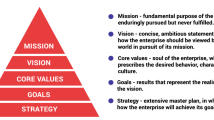Abstract
Enterprise coherence pertains to the extent to which all relevant aspects of an enterprise are connected in such a way that these connections facilitate an enterprise in obtaining/meeting its desired results. The GEA (General Enterprise Architecting) method treats enterprise coherence as something that can be governed explicitly. GEA’s Enterprise Coherence Framework (ECF) is qualitative in nature. Being able to really measure enterprise coherence would greatly support the analysis of enterprise coherence. In this paper we setup a research approach for developing enterprise coherence metrics and perform a first step in working towards an Enterprise Coherence Quantification Framework (ECQF) as part of a methodology. A case from GEA training practice is used for validation of a first application of the ECQF.
Access this chapter
Tax calculation will be finalised at checkout
Purchases are for personal use only
Similar content being viewed by others
References
Brin, S., Page, L.: The anatomy of a large-scale hypertextual web search engine. Comput. Netw. ISDN Syst. 30(1–7), 107–117 (1998)
Watts, D.J., Strogatz, S.H.: Collective dynamics of ‘smallworld’ networks. Nature 393(6684), 440–442 (1998)
Newman, M.E.J.: Modularity and community structure in networks. Proc. Natl. Acad. Sci. 103(23), 8577–8582 (2006)
A Pocket Guide to TOGAF Version 8.1.1 Enterprise Edition. The Open Group (2007)
Allwood, C.M.: The distinction between qualitative and quantitative research methods is problematic. Qual. Quant. 46, 1417–1429 (2012)
Wagter, R.: Enterprise coherence governance. Ph.D. thesis. Radboud University, Nijmegen, The Netherlands (2013)
Wagter, R., Proper, H.A., Witte, D.: Enterprise coherence governance in the public sector – custodial institutions agency of the dutch ministry of security and justice. In: IEEE 15th Conference on Business Informatics, CBI 2013, Vienna, Austria, 15–18 July 2013, pp. 117–124. IEEE Computer Society Press, Los Alamitos (2013). https://doi.org/10.1109/CBI.2013.25. ISBN 978-0-7695-5072-5
Wagter, R.: Enterprise coherence governance. ’s-Hertogenbosch: BOXPress (2013)
Dietz, J.L.G., Hoogervorst, J.A.P.: The unifying role of enterprise engineering. In: Magalhàes, R. (ed.) Organization Design and Engineering, pp. 11–38. Palgrave Macmillan, London (2014). https://doi.org/10.1057/9781137351579_2
Simon, D., Fischbach, K., Schoder, D.: Enterprise architecture management and its role in corporate strategic management. Inf. Syst. e-Bus. Manag. 12(1), 5–42 (2014)
Wieringa, R.J.: Design Science Methodology for Information Systems and Software Engineering. Springer, Cham (2014). https://doi.org/10.1007/978-3-662-43839-8. ISBN 978-3-662-43838-1
Whitney, K., et al.: Systems theory as a foundation for governance of complex systems. Int. J. Syst. Syst. Eng. 6(1–2), 15–32 (2015)
Keating, C.B., Katina, P.F.: Complex system governance development: a first generation methodology. Int. J. Syst. Syst. Eng. 7(1–3), 43–74 (2016)
Leinwand, P., Mainardi, C.R.: Strategy That Works: How Winning Companies Close the Strategy-to-Execution Gap. Harvard Business Review Press, Boston (2016)
Potts, M., et al.: Hidden structures: using graph theory to explore complex system of systems architectures. In: International Conference on Complex Systems Design & Management (2017)
Rocha, H., et al.: DCL 2.0: modular and reusable specification of architectural constraints. J. Braz. Comput. Soc. 23, 1–25 (2017)
Rodrigues, L.S., Amaral, L.: Stakeholder perspectives on time horizon and quantification of enterprise architectures benefits/value drivers. In: Proceedings of 32nd IBIMA Conference (2018)
Thurner, S., Hanel, R., Klimek, P.: Introduction to the Theory of Complex Systems. Oxford University Press, Oxford (2018)
Cherifi, H., et al.: On community structure in complex networks: challenges and opportunities. Appl. Netw. Sci. 4(1), 1–35 (2019)
Bekel, J., Wagter, R.: Enterprise coherence metrics in enterprise decision making. In: Aveiro, D., Guizzardi, G., Pergl, R., Proper, H.A. (eds.) EEWC 2020. LNBIP, vol. 411, pp. 213–227. Springer, Cham (2021). https://doi.org/10.1007/978-3-030-74196-9_12
Bekel, J., Wagter, R.: Measurement of enterprise coherence by means of the GEA C-Index-a first investigation. In: 2020 IEEE 22nd Conference on Business Informatics (CBI), vol. 2, pp. 57–64. IEEE (2020)
Bekel, J., Wagter, R.: Quantifying Enterprise Coherence - A Design Based Comparison Of Calculation Methods (2020)
Moutsinas, G., et al.: Graph hierarchy: a novel framework to analyse hierarchical structures in complex networks. Sci. Rep. 11(1), 13943 (2021)
Proper, H.A., Wagter, R., Bekel, J.: Enterprise coherence with GEA – a 15 year co-evolution of practice and theory. In: Serral, E., Stirna, J., Ralyté, J., Grabis, J. (eds.) PoEM 2021. LNBIP, vol. 432, pp. 3–18. Springer, Cham (2021). https://doi.org/10.1007/978-3-030-91279-6_1
Stovers, R., de Ruijter, J., Wagter, R.: GEA Enterprise Architecture in Practice - Better Performance by Managing Coherence. Dialoog, Zaltbommel, the Netherlands (2021). ISBN 9789461264350
Aprile, F., Onesto, V., Gentile, F.: The small world coefficient \(4.8\pm 1\) optimizes information processing in 2D neuronal networks. NPJ Syst. Biol. Appl. 8(1), 1–11 (2022)
The Open Group. TOGAF Version 9.1. 10th. Van Haren Publishing, Zaltbommel, The Netherlands (2011). ISBN 978-9-087-53679-4
Author information
Authors and Affiliations
Corresponding author
Editor information
Editors and Affiliations
Rights and permissions
Copyright information
© 2024 The Author(s), under exclusive license to Springer Nature Switzerland AG
About this paper
Cite this paper
Bekel, J., Wagter, R., Proper, H.A., Harmsen, F. (2024). An Enterprise Coherence Quantification Framework for General Enterprise Architecting. In: Sales, T.P., de Kinderen, S., Proper, H.A., Pufahl, L., Karastoyanova, D., van Sinderen, M. (eds) Enterprise Design, Operations, and Computing. EDOC 2023 Workshops . EDOC 2023. Lecture Notes in Business Information Processing, vol 498. Springer, Cham. https://doi.org/10.1007/978-3-031-54712-6_6
Download citation
DOI: https://doi.org/10.1007/978-3-031-54712-6_6
Published:
Publisher Name: Springer, Cham
Print ISBN: 978-3-031-54711-9
Online ISBN: 978-3-031-54712-6
eBook Packages: Computer ScienceComputer Science (R0)




